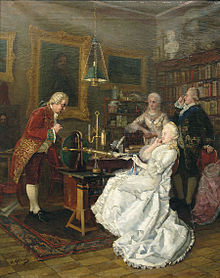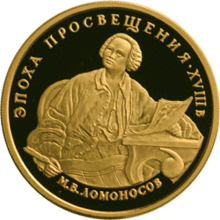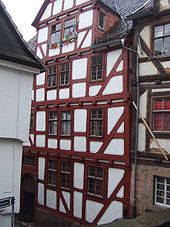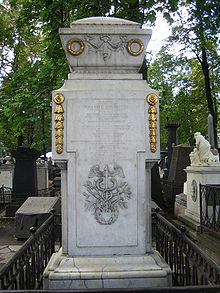- Mikhail Lomonosov
-
For other uses, see Lomonosov (disambiguation).
Mikhail Vasilyevich Lomonosov 
Native name Михайло Васильевич Ломоносов Born November 19, 1711
Denisovka, Arkhangelsk GovernorateDied April 15, 1765 (aged 53)
Saint PetersburgEthnicity Russian Occupation Sphere of science: natural science, chemistry, physics, mineralogy, history, philology, optical devices and others. Lomonosov was also a poet. Spouse Elisabeth Zilch Children Yelena Mikhail Vasilyevich Lomonosov (Russian: Михаи́л Васи́льевич Ломоно́сов; November 19 [O.S. November 8] 1711 – April 15 [O.S. April 4] 1765) was a Russian polymath, scientist and writer, who made important contributions to literature, education, and science. Among his discoveries was the atmosphere of Venus. His spheres of science were natural science, chemistry, physics, mineralogy, history, art, philology, optical devices and others. Lomonosov was also a poet, who created the basis of the modern Russian literary language.
Contents
Early life and family
Lomonosov was born in the village of Denisovka (later renamed Lomonosovo in his honor) in the Arkhangelsk Governorate, on an island not far from Kholmogory, in the Far North of Russia.[1] His father, Vasily Dorofeyevich Lomonosov, was a prosperous peasant fisherman turned ship owner, who amassed a small fortune transporting goods from Arkhangelsk to Pustozyorsk, Solovki, Kola, and Lapland.[1] Lomonosov’s mother was Vasily’s first wife, a deacon’s daughter, Elena Ivanovna Sivkova.[2]
He remained at Denisovka until he was ten, when his father decided that he was old enough to participate in his business ventures, and Lomonosov began accompanying Vasily on trading missions.[2]
Learning was young Lomonosov's passion, however, not business. The boy's thirst for knowledge was insatiable. Lomonosov had been taught to read as a boy by his neighbor Ivan Shubny, and he spent every spare moment with his books.[2] He continued his studies with the village deacon, S.N. Sabelnikov, but for many years the only books he had access to were religious texts. When he was fourteen, Lomonosov was given copies of Meletius Smotrytsky's Modern Church Slavonic (a grammar book) and Leonty Magnitsky's Arithmetic.[3]
In 1724, his father married for the third and final time. Lomonosov and his stepmother Irina had an acrimonious relationship. Unhappy at home and intent on obtaining a higher education, which Lomonosov could not receive in Denisovka, he was determined to leave the village.[4]
Education in Moscow
In 1730, at nineteen, Lomonosov joined a caravan traveling to Moscow.[4] Not long after arriving, Lomonosov obtained admission into the Slavic Greek Latin Academy by falsely claiming to be a priest’s son.[5] That initial falsehood would nearly get him expelled from the academy a few years later when discovered.[6]
Lomonosov lived on three kopecks a day, living off only black bread and kvas, but he made rapid progress scholastically.[7] After three years in Moscow he was sent to Kiev to study for one year at the Kyiv-Mohyla Academy. He quickly became dissatisfied with the education he was receiving there, and returned to Moscow several months ahead of schedule, resuming his studies there.[7] He completed a twelve-year study course in only five years, graduating at the top of his class. In 1736, Lomonosov was awarded a scholarship to Saint Petersburg State University.[8] He plunged into his studies and was rewarded with a two-year grant to study abroad at the University of Marburg, in Germany.[9]
Education abroad
The University of Marburg was among Europe's most important universities in the mid-18th century due to the presence of the philosopher Christian Wolff, a prominent figure of the German Enlightenment. Lomonosov became one of Wolff’s personal students while at Marburg. Both philosophically and as a science administrator, this connection would be the most influential of Lomonosov’s life.[10]
 The most grandiose of Lomonosov's mosaics depicts the Battle of Poltava.
The most grandiose of Lomonosov's mosaics depicts the Battle of Poltava.
Lomonosov quickly mastered the German language, and in addition to philosophy, seriously studied chemistry, discovered the works of 17th century English theologian and natural philosopher, Robert Boyle, and even began writing poetry. He also developed an interest in German literature. He is said to have especially admired Günther. His Ode on the Taking of Khotin from the Turks, composed in 1739, attracted a great deal of attention in Saint Petersburg.[10]
During his residence in Germany, Lomonosov boarded with Catharina Zilch, a brewer’s widow.[11] He fell in love with Catharina’s daughter Elisabeth Christine Zilch. They were married in June 1740.[12] Lomonosov found it extremely difficult to maintain his growing family on the scanty and irregular allowance granted him by the Russian Academy of Science. As his circumstances became desperate, he resolved to return to Saint Petersburg.[10]
Return to Russia
Lomonosov returned to Russia in 1741. A year later he was named adjutant to the Russian Academy of Science in the physics department.[10] In May 1743, Lomonosov was accused, arrested, and held under house arrest for eight months, after he supposedly insulted various people associated with the Academy. He was released and pardoned in January 1744 after apologising to all involved.[10]
Lomonosov was made a full member of the Academy, and named professor of chemistry, in 1745.[10] He established the Academy's first chemistry laboratory.[13] Eager to improve Russia’s educational system, in 1755, Lomonosov joined his patron Count Ivan Shuvalov in founding the Moscow State University.[13]
Physicist
 Catherine II of Russia visits Mikhail Lomonosov in 1764. 1884 painting by Ivan Fyodorov
Catherine II of Russia visits Mikhail Lomonosov in 1764. 1884 painting by Ivan Fyodorov
In 1756, Lomonosov tried to replicate Robert Boyle's experiment of 1673.[14] He concluded that the commonly accepted phlogiston theory was false. Anticipating the discoveries of Antoine Lavoisier, he wrote in his diary: "Today I made an experiment in hermetic glass vessels in order to determine whether the mass of metals increases from the action of pure heat. The experiments– of which I append the record in 13 pages– demonstrated that the famous Robert Boyle was deluded, for without access of air from outside the mass of the burnt metal remains the same".
He regarded heat as a form of motion, suggested the wave theory of light, contributed to the formulation of the kinetic theory of gases, and stated the idea of conservation of matter in the following words: "All changes in nature are such that inasmuch is taken from one object insomuch is added to another. So, if the amount of matter decreases in one place, it increases elsewhere. This universal law of nature embraces laws of motion as well, for an object moving others by its own force in fact imparts to another object the force it loses" (first articulated in a letter to Leonhard Euler dated 5 July 1748, rephrased and published in Lomonosov's dissertation "Reflexion on the solidity and fluidity of bodies", 1760).
Astronomer
In 1762, Lomonosov presented an improved design of a reflecting telescope to the Russian Academy of Sciences forum. His telescope had its primary mirror adjusted at four degrees to telescope's axis. This made the image focus at the side of the telescope tube. There the observer could view the image with an eyepiece without blocking the image. However, this invention was not published until 1827, so this type of telescope has become associated with a similar design by William Herschel, the Herschelian telescope.[15] Lomonosov was the first person to hypothesize the existence of an atmosphere on Venus based on his observation of the transit of Venus of 1761 in a small observatory near his house in Petersburg.[10]
Chemist
Lomonosov was the first person to record the freezing of mercury. Believing that nature is subject to regular and continuous evolution, he demonstrated the organic origin of soil, peat, coal, petroleum and amber. In 1745, he published a catalogue of over 3,000 minerals, and in 1760, he explained the formation of icebergs.[10]
Geographer
Lomonosov's observation of iceberg formation led into his pioneering work in geography. Lomonosov got close to the theory of continental drift,[16] theoretically predicted the existence of Antarctica (he argued that icebergs of the South Ocean could only be formed on a dry land covered with ice),[17] and invented sea tools which made writing and calculating directions and distances easier. In 1764, he organized an expedition (led by Admiral Vasili Chichagov) to find the Northeast Passage between the Atlantic and Pacific oceans by sailing along the northern coast of Siberia.[10]
Mosaicist
Lomonosov was proud to restore the ancient art of mosaics. In 1754, in his letter to Leonard Euler, he wrote that his three years of experiments on the effects of chemistry of minerals on their colour led to him became very involved into the mosaics art. In 1763, he set up a glass factory that produced the first stained glass mosaics outside of Italy. There were forty mosaics attributed to Lomonosov, with only twenty-four surviving to the present day. Among the best is the portrait of Peter the Great and the Battle of Poltava, measuring 4.8 × 6.4 meters.[18][19][20]
Poet
In 1755, he wrote a grammar that reformed the Russian literary language by combining Old Church Slavonic with the vernacular tongue. To further his literary theories, he wrote more than 20 solemn ceremonial odes, notably the Evening Meditation on the God's Grandeur. He applied an idiosyncratic theory to his later poems– tender subjects needed words containing the front vowel sounds E, I, YU, whereas things that may cause fear (like "anger", "envy", "pain" and "sorrow") needed words with back vowel sounds O, U, Y. That was a version of what is now called sound symbolism. Lomonosov published a history of Russia in 1760. In addition, he unsuccessfully attempted to write an epic about Peter the Great, to be based on the Aeneid by Vergil. In 1761, he was elected a foreign member of the Royal Swedish Academy of Sciences. In 1764, Lomonosov was appointed to the position of secretary of state. He died one year later in Saint Petersburg. Most of his accomplishments were unknown outside Russia until long after his death.
Legacy
 1992 Russian gold coin.
1992 Russian gold coin.
His granddaughter Sophia Konstantinova (1769–1844) married Russian military hero and statesman General Nikolay Raevsky. His great-granddaughter was Princess Maria (Raevskaya) Volkonskaya, the wife of the Decembrist Prince Sergei Volkonsky.[21]
A lunar crater bears his name, as does a crater on Mars. In 1948, the underwater Lomonosov Ridge in the Arctic Ocean was named in his honor. Moscow State University was renamed ‘’M. V. Lomonosov Moscow State University’’ in his honor in 1940.
Lomonosov Gold Medal was established in 1959 and is awarded annually by the Russian Academy of Sciences to a Russian and a foreign scientists.
See also
- Moscow State University
- Lomonosov, Russia
- Lomonosov Porcelain Factory
- Ivan Kulibin
References
- ^ a b Menshutkin, Boris N. Russia's Lomonosov, Chemist Courtier, Physicist Poet, Page 11. Princeton University Press: Princeton, 1952.
- ^ a b c Menshutkin, Boris N. Russia's Lomonosov, Chemist Courtier, Physicist Poet, Page 12. Princeton University Press: Princeton, 1952.
- ^ Menshutkin, Boris N. Russia's Lomonosov, Chemist Courtier, Physicist Poet, Page 13. Princeton University Press: Princeton, 1952.
- ^ a b Menshutkin, Boris N. Russia's Lomonosov, Chemist Courtier, Physicist Poet, Page 15. Princeton University Press: Princeton, 1952.
- ^ Menshutkin, Boris N. Russia's Lomonosov, Chemist Courtier, Physicist Poet, Page 16. Princeton University Press: Princeton, 1952.
- ^ Menshutkin, Boris N. Russia's Lomonosov, Chemist Courtier, Physicist Poet, Page 20. Princeton University Press: Princeton, 1952.
- ^ a b Menshutkin, Boris N. Russia's Lomonosov, Chemist Courtier, Physicist Poet, Page 17. Princeton University Press: Princeton, 1952.
- ^ Menshutkin, Boris N. Russia's Lomonosov, Chemist Courtier, Physicist Poet, Page 23. Princeton University Press: Princeton, 1952.
- ^ Menshutkin, Boris N. Russia's Lomonosov, Chemist Courtier, Physicist Poet, Page 24. Princeton University Press: Princeton, 1952.
- ^ a b c d e f g h i Menshutkin, Boris N. Russia's Lomonosov, Chemist Courtier, Physicist Poet. Princeton University Press: Princeton, 1952.
- ^ Pavlova, Galina E., and Fedorov, Aleksandr S. Mikhail Vasilievich Lomonosov: His Life and Work (English Translation). Mir: Moscow, 1980.
- ^ Pavlova, Galina E., and Fedorov, Aleksandr S. Mikhail Vasilievich Lomonosov: His Life and Work (English Translation). Mir: Moscow, 1980. ISBN 0828528950, 9780828528955
- ^ a b Cornwell, Neil and Christian, Nicole. Reference Guide to Russian Literature, Page 514. Taylor & Francis: London, 1998
- ^ Menshutkin, Boris N. Russia's Lomonosov, Chemist Courtier, Physicist Poet, Page 120. Princeton University Press: Princeton, 1952.
- ^ "On an optic pipe improvement" — Lomonosov M.V. Selected works in two volumes. Volume I: Natural sciences and philosophy. Moscow: Nauka (Science) publishing house, 1986 (Russian). Name in Russian: «Об усовершенствовании зрительных труб» — М. В. Ломоносов. Избранные произведения. В двух томах. Т. 1. Естественные науки и философия. М.: Наука. 1986
- ^ Life and Death of Alfred Wegener by Alexey Fedorchuk (Russian)
- ^ Eduard Belcher Prediction of Antarctica by Lomonosov (Russian)
- ^ Elena Lavrenova. "Lomonsov biography". Foxdesign.ru. http://www.foxdesign.ru/aphorism/biography/lomonosov.html. Retrieved 2011-05-02.
- ^ "М. В. Ломоносов: к 300-летию со дня рождения". narfu.ru. http://www.narfu.ru/lomonosov. Retrieved 2011-05-02.
- ^ "''М. А. Безбородое'' М.В.Ломоносов. Фабрика В Усть-Рудицах". Grokhovs1.chat.ru. 2001-12-05. http://grokhovs1.chat.ru/lomonos/lomono5.html. Retrieved 2011-05-02.
- ^ Sutherland, Christine (1984). The Princess of Siberia: The Story of Maria Volkonsky and the Decembrist Exiles. New York: Farrar, Straus and Giroux. ISBN 0374237271.
Further reading
- C. A. Johnson (June 1964). "Lomonosov's Dedication to His Russian grammar". Slavic Review 23 (2): 328–332. doi:10.2307/2492939.
- Peter Hoffmann: Michail Vasil'evič Lomonosov (1711 - 1765). Ein Enzyklopädist im Zeitalter der Aufklärung. Frankfurt am Main: Peter Lang, 2011. ISBN 978-3-631-61797-7
External links
- Сайт о М. В. Ломоносове — жизнь, научная деятельность, творчество, историческая родина, туризм на родину Ломоносова, 300-летний юбилей М. В. Ломоносова (Russian)
- Lomonosov and His Time — electronic collection at the Russian Academy of Sciences website (Russian)
- Illustrated chronology of Lomonosov's life
- Evening Meditation on the Greatness of God on the occasion of the Northern Lights
- (Russian) The descendants Mikhail Vasilyevich Lomonosov
- Mikhail Lomonosov at Find a Grave
- Kutateladze S.S. The Mathematical Background of Lomonosov's Contribution
- Lomonosov's matriculation, Marburg 1736
- Lomonosov's Passport, Marburg 1741
Figures in the Age of Enlightenment by country or region Notable figures America (English) America (Latin) England Edward Gibbon · Thomas Hobbes · Samuel Johnson · Edmund Burke (Irish born) · John Locke · Isaac Newton · Robert WalpoleFrance Germany Greece Hungary Italy Low Countries Poland-Lithuania Portugal Romanian States Russia Mikhail Lomonosov · Ivan Shuvalov · Ivan Betskoy · Ekaterina Dashkova · Nikolay Novikov · Mikhail Shcherbatov · Alexander RadishchevScandinavia Scotland Serbia Spain Ukraine Related topics Categories:- Enlightenment scientists
- Russian artists
- Russian astronomers
- Russian chemists
- Russian geographers
- Russian historians
- Russian inventors
- Russian linguists
- Russian physicists
- Russian poets
- Moscow State University faculty
- Members of the Russian Academy of Sciences
- Pomors
- Alumni of the National University of Kyiv-Mohyla Academy
- Members of the Royal Swedish Academy of Sciences
- 1711 births
- 1765 deaths
Wikimedia Foundation. 2010.


